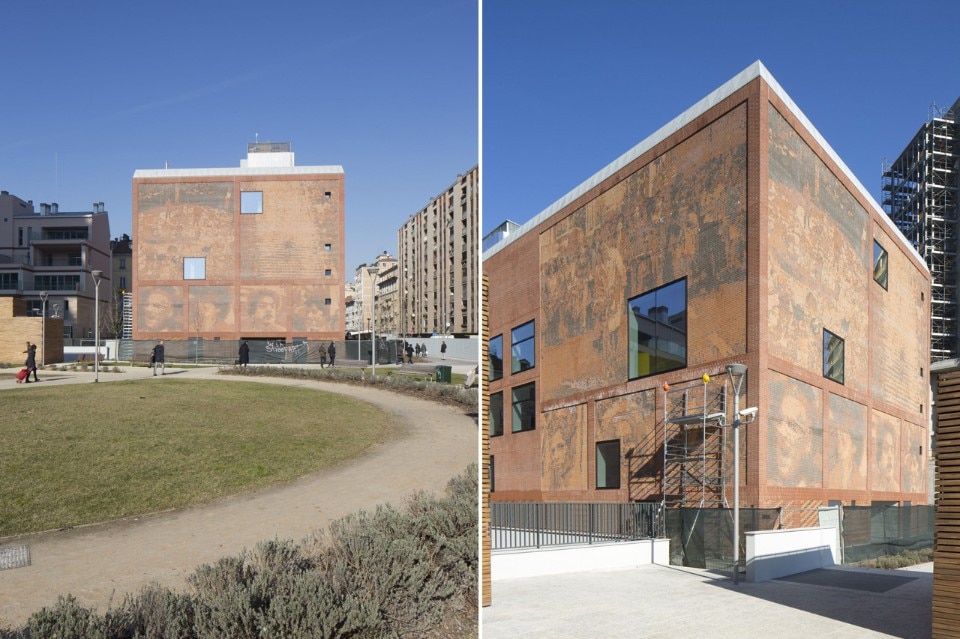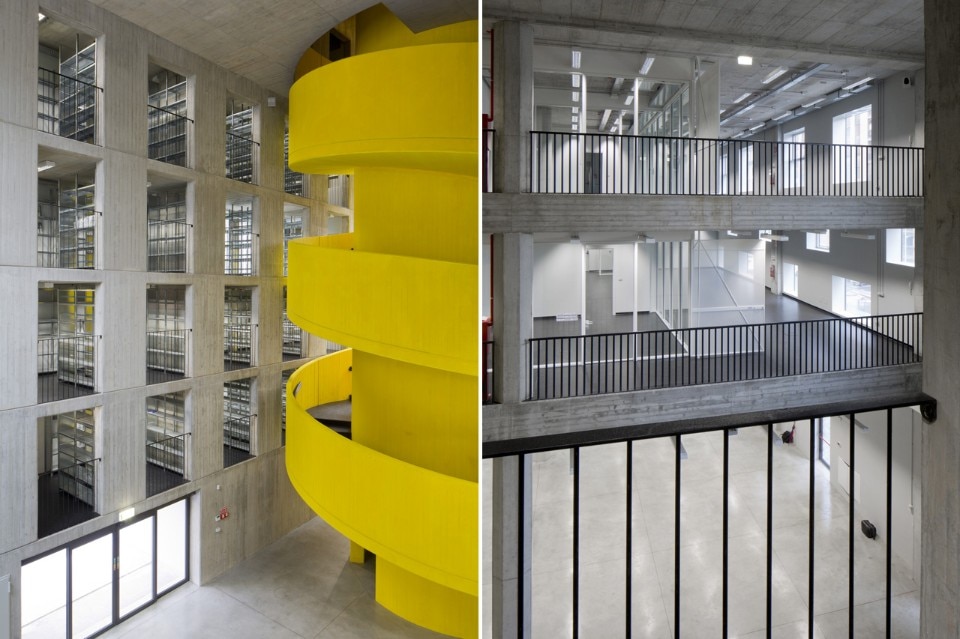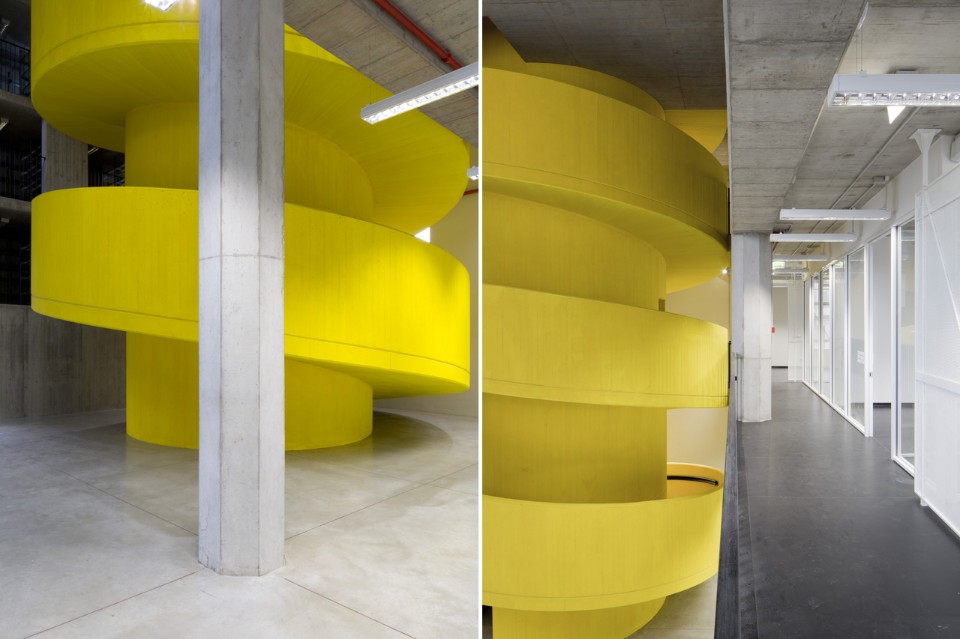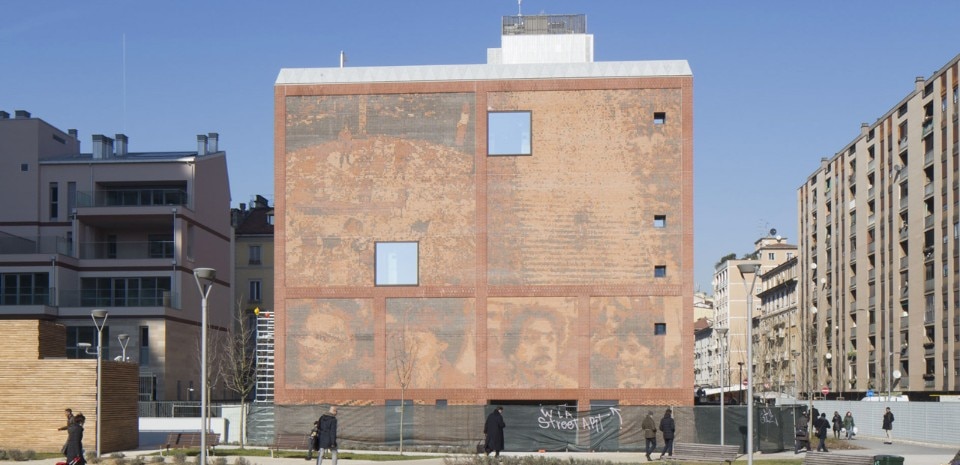
It is impossible to ignore that the House of Memory is a monument, although it operates in a society without any precise collective goals to assign to architecture. Instead of opposing this unclear condition, the architects imagined how to profit from it. In fact, it is precisely in this complex dimension that the potential of the new building lies: in the possibility of combining the slowness and inertia of architecture with the multiplicity and rapidity of contemporary media. Rather than awkwardly following in the footsteps of contemporary communication technologies through a medium as static as architecture (and rather than reducing the complexity of contemporary technology and media to the unavoidable immobility of architecture), they chose to underscore the potential difference between the House of Memory’s solid exoskeleton and its fluid and mutating content.
The new building highlights the complementarity of material and immaterial archives: different styles of memory coincide in an object that is ready to establish a dialogue with different audiences without renouncing the possibility of providing a unified representation. Thus a permanent stage set appears alongside a changing scenery, thereby producing a machine of memory that is both complex and univocal, both slow and mutating, and both multiple and immovable. The new building profits from both its weight and its lightness. As an open and continuously updated archive, the House of Memory is ready to play host to a multitude of informal and unforeseen uses. As a heavy, compact volume, the House of Memory displays its inertia, choosing to remain a stumbling block left to hinder and repeat its own testimony.
Rather than considering the House of Memory as an expression of shared memory, baukuh preferred considering it as a tool for discussing the different elements that coexist within the collective memory of the city. The House of Memory tries to provide a shelter for the various and varied memories that are woven not only into contemporary society, but also in the minds of individuals. Firm, long-term memories thus coexist inside all of us with our own fleeting, delicate memories; public memories go hand in hand with private ones; explicit memories cannot be separated from unconscious ones.
The House of Memory is entirely covered with large images depicting Milan’s recent history. The shell of the new building is understood as a contemporary polyptych: this collection of images tries to suggest with great immediacy both the complexity and the ideal unity of Milan’s collective memory. The decorated façade, more than defining a shared memory, exposes the need for such sharing. For this reason the images collected on the envelope of the House of Memory are at the same time explicitly monumental and deliberately fragile. In fact, given their construction, the images appear more clearly from afar and then they lose clarity by coming closer. They dissolve into a sort of floating dust, as if they would finally be unsure about the very same truth that they so proudly accepted to expose.
The iconographic program, carefully defined by a Scientific Committee, is made of nineteen portraits of anonymous Milanese citizens, which suggest the multiplicity of the populations that animated the city in the post-war period, and of eight historical images which record eight moments in the recent history of the city such as the deportation to concentration camps, the Liberation from Nazi-Fascism, the piazza Fontana bombing of 12 December 1969. This exterior decoration in polychrome brickwork establishes a direct relation with the Lombard tradition of buildings such as the Ospedale Maggiore and Santa Maria delle Grazie

The building – a simple box with a rectangular base – is divided into three parts that are connected to one another by an entirely open ground floor. Two thin layers along the building’s shorter ends house the archive (South), the restrooms and technical installations (North), and the vertical circulation. The open space at the ground floor is subdivided in three parts by two octagonal columns. One third of this area reaches the building’s full height and includes a spiral staircase. The rest is occupied by exhibition spaces and offices disposed on three levels. This internal organization – with the enormous, yellow staircase inserted between the three levels of offices and exhibition spaces and the five levels of archive – introduces a greater scale into the building. The contrast between the tight levels of the archive and the colossal dimension the staircase allows the office and exhibition spaces to acquire spaciousness; the visitor perceives a vaster, more generous atmosphere.
The yellow staircase is not only the building’s main distributive element, but it is also the device that establishes a relation among the visitors and the collection. Given that the preciousness of the archive does not allow the visitors to directly access to the documents, the relationship between the citizens and the collection is established through the rotating movement created by the staircase. The visitor repeatedly comes closer to and then moves away from the collection, thereby experiencing a complex sequence of views of the documents and, behind them, of the park outside.
Light enters the building in many fashions. The offices have large windows concentrated in the corresponding parts of the façade. The building’s open-space configuration and internal subdivision with glass emphasize the abundance of light. The entrance hall, the large staircase and the ground floor receive light from a handful of very large openings; grazing light invades the semi-darkness and generates a calm and solemn space.

opening April 24–25
Casa della Memoria, via Confalonieri 14, Milano
Program: public building
Architects: studio associato baukuh
Client: Comune di Milano
Developer: Hines Italia Sgr Spa
Structures: Arup Italia srl
HVAC: Deerns Italia spa
Fire protection engineering: Gaeengineering srl
Quantity surveyor: J&A consultants srl
Contractor: Edilda Edilizia Lombarda spa
Area: 2,500 mq
Cost: 3,600,000 €
Completion: 2015


